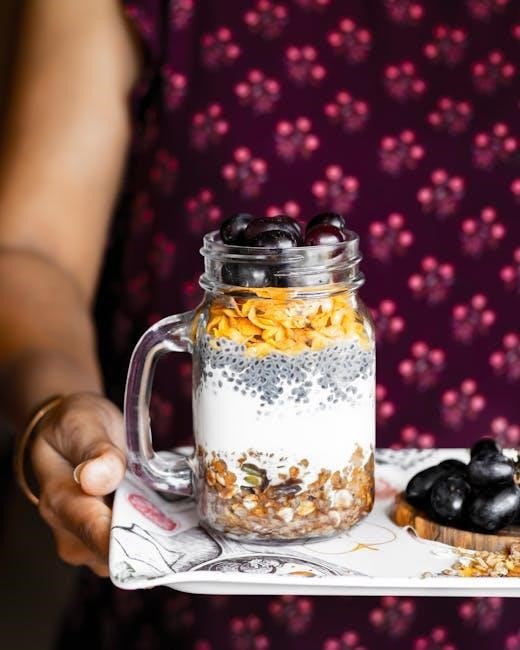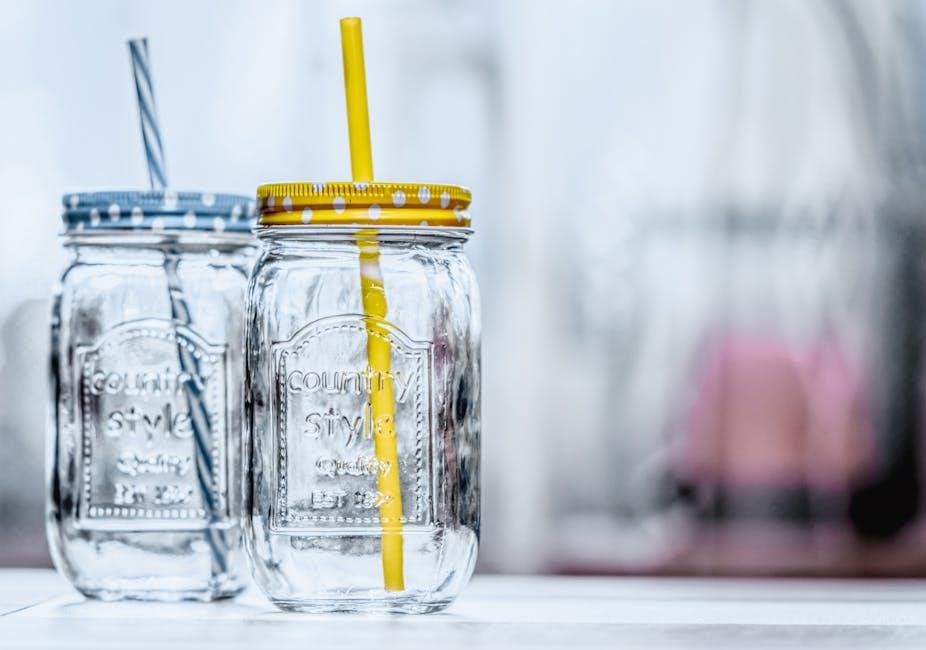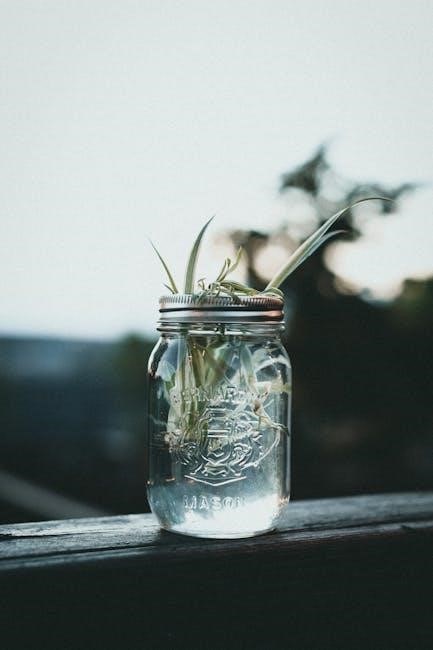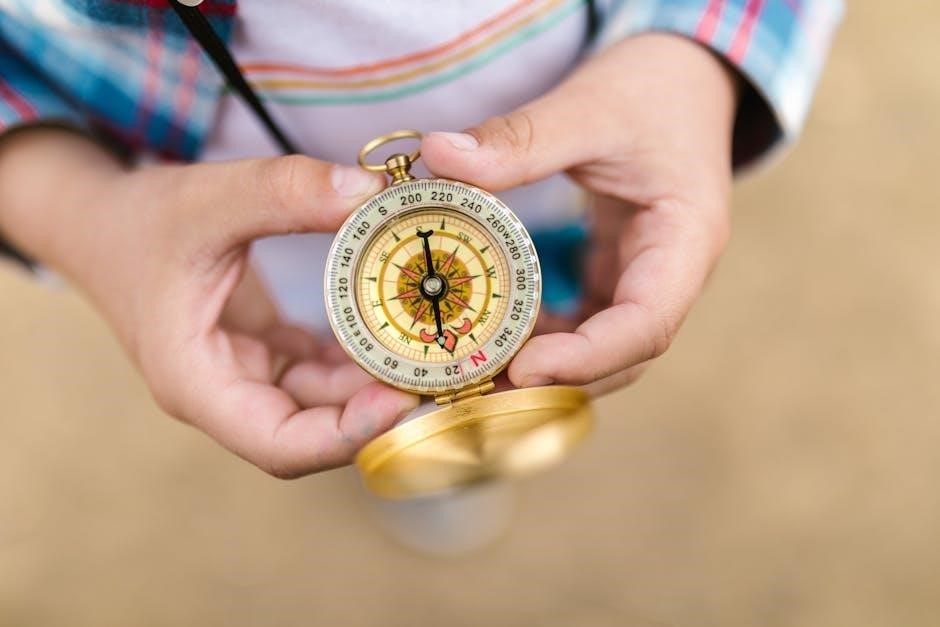
mason jar collectors guide
Mason jar collecting is a fascinating hobby that combines history, craftsmanship, and practicality. From canning to home decor, these jars have evolved into treasured collectibles. With their timeless design and versatility, mason jars attract both seasoned collectors and newcomers. Learn how to identify rare finds, understand their historical significance, and care for your collection. This guide offers insights into the world of mason jars, helping you build a meaningful and valuable collection.
What is Mason Jar Collecting?
Mason jar collecting is a hobby centered around gathering and preserving Mason jars, cherished for their historical significance, craftsmanship, and sentimental value. Collectors often seek jars from specific brands like Ball or Kerr, with particular interest in rare colors, unique designs, and different sizes. The pursuit involves hunting through antique shops, flea markets, and estate sales, valuing jars in good condition. The community aspect thrives through clubs and conventions, where enthusiasts trade and share knowledge. This hobby combines history, aesthetics, and the thrill of the hunt, making it a rewarding and educational pastime.
Why Collect Mason Jars?
Collecting Mason jars offers a blend of nostalgia, historical connection, and personal satisfaction. Many are drawn to their timeless design and the stories they hold, while others appreciate their practical uses in canning and home decor. The thrill of discovering rare or vintage jars adds an exciting element to the hobby. Additionally, Mason jars are sustainable and versatile, making them a meaningful addition to any collection, whether for functional purposes or as cherished antiques.
Understanding Mason Jars
Mason jars are iconic glass containers known for their durability and versatility. Originally designed for canning, they now serve various purposes, from food storage to home decor, making them a timeless favorite among collectors and households alike.
A Brief History of Mason Jars
Mason jars were first patented in 1858 by John L. Mason, revolutionizing food preservation. By the early 1900s, companies like Ball became prominent, producing jars that combined functionality with timeless design. Initially used for canning, their popularity grew as they became symbols of self-sufficiency. Over the decades, mason jars transitioned from practical tools to coveted collectibles, with vintage jars now highly sought after for their historical significance and aesthetic appeal, reflecting their enduring legacy in both utility and culture.
Popular Uses for Mason Jars
Mason jars are incredibly versatile, serving as storage containers for food, crafts, and home decor. They are ideal for canning, preserving, and freezing, as well as fermenting foods to enhance nutritional value. Beyond the kitchen, they are used in DIY projects, such as creating lamps or vases, and even in gardening for seed starting. Their durability and sealability make them a practical choice for both everyday use and creative endeavors, appealing to a wide range of enthusiasts and homemakers alike.
Types and Brands of Mason Jars
Mason jars come in various styles, with Ball and Kerr being the most iconic brands. Popular colors include blue, green, and clear, often sought by collectors for their rarity and charm.
Common Types of Mason Jars
Mason jars are categorized by size, shape, and purpose. Standard sizes range from 4 to 32 ounces, while wide-mouth and narrow-mouth variations offer versatility. Heritage and reproduction styles mimic vintage designs, appealing to collectors. Specialty jars, like fermentation and jelly jars, serve specific functions. Colors such as blue, green, and amber add rarity, with clear jars being the most common. Each type holds unique charm, making them desirable for collectors and practical for everyday use.
Well-Known Brands and Their History
Prominent brands like Ball, Kerr, and Atlas have shaped the history of mason jars. Ball, founded in 1880, became iconic for its reliable glass jars. Kerr emerged in the early 20th century, known for its wide-mouth designs. Atlas jars, produced from the 1930s to 1980s, are prized for their unique colors. Each brand’s logo and manufacturing marks have evolved, aiding collectors in dating and authenticating their finds. These brands’ legacies continue to influence modern mason jar production and collecting trends.

Dating Mason Jars
Dating mason jars involves examining logos, marks, and historical records. Logos and patent dates are key indicators, as brands like Ball and Kerr updated designs over time. Color and glass clarity also hint at age, with older jars often having distinct hues and imperfections. By combining these factors, collectors can accurately determine the era of their mason jars, enhancing their value and historical significance.
How to Determine the Age of a Mason Jar
To determine the age of a mason jar, examine its logo, shape, and mold numbers. Logos and trademarks often change over time, providing clues about the era. Jar shapes and sizes can indicate their intended use and production period. Mold numbers on the base help trace the jar to specific manufacturing runs. Additionally, lid styles and sealing mechanisms evolve, offering further insight into the jar’s history. These details collectively help pinpoint the age accurately.
Key Features for Dating Accuracy
Key features for dating mason jars include logos, shapes, mold numbers, and lids. Logos often change over time, helping identify the era. Jar shapes and sizes indicate their use and production period. Mold numbers on the base trace manufacturing runs. Lid styles and mechanisms evolve, offering dating clues. Together, these elements enhance accuracy in determining a jar’s age and historical significance.
Rarity and Value of Mason Jars
Rarity and value of mason jars depend on age, condition, and brand. Vintage jars in rare colors like blue or green are highly sought after. Condition impacts value, with chips or cracks reducing worth. Brands like Ball and Kerr are popular among collectors. Understanding these factors helps in evaluating and potentially selling your collection for its best market value.
Factors Influencing Rarity
Rarity of mason jars is influenced by color, brand, and condition. Jars in rare colors like blue or green are highly sought after, with clear jars being more common. Brands such as Ball and Kerr are popular among collectors, and their age can significantly impact rarity. Additionally, condition plays a crucial role, with chips or cracks reducing value. Demand for specific designs or historical significance also drives rarity, making certain jars more valuable than others in the market.
Evaluating the Value of Your Collection
Evaluating your mason jar collection involves understanding market trends, condition, and rarity. Researching similar jars online and consulting collectors can provide insights into their value. Condition is critical, with chips or cracks reducing worth. Professional appraisals can offer accurate assessments. Additionally, brand, age, and historical significance influence value. Stay informed about market demand and trends to ensure your collection is fairly valued and optimally maintained for future appreciation.

Sizes and Shapes of Mason Jars
Mason jars come in various sizes, from half-pint to quart, and shapes like square or hexagonal. Each offers unique storage and display possibilities.
Standard Sizes Available
Mason jars are produced in various standard sizes, including half-pint, pint, quart, and half-gallon capacities. These sizes are ideal for canning, storage, and display. The most common size is the quart jar, widely used for preserving food. Half-pint jars are perfect for jams and sauces, while half-gallon jars are great for bulk storage. Each size offers practicality and versatility, making them popular among collectors and home preservers alike.
Unique and Specialty Shapes
Mason jars come in unique and specialty shapes, adding charm to collections. Heritage shapes, like the 1915 “Perfect Mason” jar, feature distinctive embossing. Some jars boast rounded shoulders or cylindrical designs, while others have decorative handles. Specialty shapes, such as square or hexagonal jars, offer functional and aesthetic appeal. These uncommon forms make them highly sought after by collectors, blending historical character with practical use in modern settings.
Maintenance and Care
Regular cleaning with mild soap and water is essential. Dry thoroughly to prevent water spots. Store in a cool, dry place to preserve condition. Always inspect for chips or cracks before use to ensure safety and longevity of your mason jars.
Proper Cleaning Techniques
Clean mason jars with mild soap and warm water, using a soft brush to remove residue. Avoid harsh chemicals or abrasive scrubbers. Rinse thoroughly to eliminate soap residue. For tough stains, soak jars in hot water before cleaning. Always dry jars completely to prevent water spots. For vintage jars, gentle cleaning is crucial to preserve their condition and value. Regular maintenance ensures your collection remains pristine and functional for years.
Storage Solutions for Preservation
Store mason jars in a cool, dry place away from direct sunlight to prevent fading. Use acid-free tissue or cloth to protect lids and seals. For display, consider glass-front cabinets or shelves. When stacking, place paper separators between jars to avoid chipping; Label each jar with its origin and date for easy identification. Proper storage ensures your collection remains in excellent condition, preserving its historical and monetary value over time.
Troubleshooting Common Issues
Identify sealing problems by checking lids for rust or dents. Chips or cracks can compromise a jar’s integrity. Regularly inspect jars for wear and tear to prevent leaks and ensure longevity. Proper maintenance is key to avoiding common issues and preserving functionality. Addressing problems early helps maintain the value and usability of your mason jar collection.
Identifying and Solving Sealing Problems
Common sealing issues in mason jars often stem from worn or damaged lids. Inspect for rust, dents, or uneven surfaces. Clean lids thoroughly before use to ensure a tight seal. Replace faulty lids with new ones for better performance. For persistent issues, consider experimenting with alternative sealing methods, such as oak lids, which some collectors find advantageous. Proper sealing is crucial for preservation and maintaining the jar’s functionality and value.
Repairing Chips and Cracks
Repairing chips and cracks in mason jars requires careful assessment. For minor damage, food-safe epoxy can be used to seal cracks, ensuring the jar remains functional. Sanding rough edges prevents further chipping. However, deep cracks may render the jar unsafe for canning. Consider repurposing such jars for storage or decor. Regular maintenance, like checking lids and storing jars properly, helps prevent damage. Always prioritize safety and functionality when repairing your mason jars.

Display and Storage Ideas
Showcase your mason jar collection creatively with wooden shelves, rustic crates, or glass cabinets. For storage, use labels and protective materials to prevent damage and ensure longevity.
Creative Ways to Showcase Your Collection
Highlight your mason jars with unique displays like vintage wooden shelves or glass-front cabinets. Add decorative touches such as ribbons, labels, or fairy lights for charm. Use jar racks or hanging organizers to maximize space. Incorporate themed setups, like pairing jars with antique utensils or seasonal decor. For a rustic look, arrange jars in woven baskets or crates. These creative ideas will make your collection a focal point in any room, blending functionality with aesthetic appeal.
Practical Storage Solutions
Store your mason jars securely using stackable plastic bins or drawer organizers. Keep lids separate in small compartments to prevent scratching. Label each container for easy access. Utilize vertical space with wall-mounted shelves or pegboards. For long-term storage, consider climate-controlled areas to prevent moisture damage. These solutions help maintain your collection’s condition while keeping it organized and easily accessible for future use or display.

Investment Potential
Mason jars can be valuable investments, especially rare or vintage pieces. Researching market trends and understanding demand helps maximize returns. Consider appraisals for unique jars to ensure informed purchasing decisions.
Assessing Market Value
Assessing the market value of mason jars involves evaluating rarity, condition, and demand. Rare colors like blue and green often fetch higher prices. Check for sealing issues and chips, as these can lower value. Research recent sales of similar jars to gauge market trends. Consult experts or online marketplaces for accurate appraisals. Condition and historical significance are key factors in determining worth.
Selling and Trading Tips
When selling mason jars, high-quality images and detailed descriptions are essential. Use online platforms like eBay or Etsy for wider reach. Research similar listings to set competitive prices. Highlight rare colors, sizes, or historical significance to attract collectors. Consider trading with other enthusiasts for rare pieces. Clean and well-sealed jars often sell faster. Showcase unique features like embossing or vintage lids to maximize value.
Future Trends
Mason jar collecting is expected to grow, driven by sustainability trends and vintage appeal. Innovative designs and eco-friendly practices will likely influence future collector preferences, ensuring enduring popularity.
Emerging Trends in Collecting
Mason jar collecting is evolving, with a growing emphasis on sustainability and eco-consciousness. Collectors are seeking rare colors and unique sizes, while others focus on vintage lids and rims. The rise of online marketplaces has made it easier to discover and trade jars globally. Additionally, creative uses for mason jars in home decor and crafting are inspiring new generations of collectors, ensuring the hobby remains vibrant and dynamic.
Building a Sustainable Collection
Building a sustainable mason jar collection involves eco-friendly practices and mindful preservation. Reuse jars for canning, freezing, or home decor to reduce waste. Opt for high-quality, durable pieces to ensure longevity. Store jars in protective environments, avoiding direct sunlight. Prioritize ethical sourcing by purchasing from reputable sellers or estate sales. Focus on quality over quantity to maintain a curated collection. Regular maintenance ensures your jars remain functional and treasured for years to come.
Mason jar collecting is a rewarding journey blending history, craftsmanship, and practicality. From understanding their origins to preserving their condition, this guide has equipped you with essential knowledge. Whether you’re a seasoned collector or just starting, mason jars offer endless possibilities for creativity and sustainability. Embrace the joy of the hunt, cherish your collection, and continue exploring the timeless charm of these iconic jars.
Related Posts

scouts guide to the zombie apocalypse boob
Discover the ultimate zombie survival tips and hilarious adventures with the scouts! Your go-to guide for apocalypse prep and laughs.

th3210d1004 installation guide
Learn how to install your TH3210D1004 with our comprehensive, easy-to-follow guide. Get your device up and running effortlessly!

nami waiver guide
Discover the ultimate Nami Waiver Guide, packed with step-by-step instructions and expert tips to help you navigate the process effortlessly. Get approved faster with our comprehensive guide.